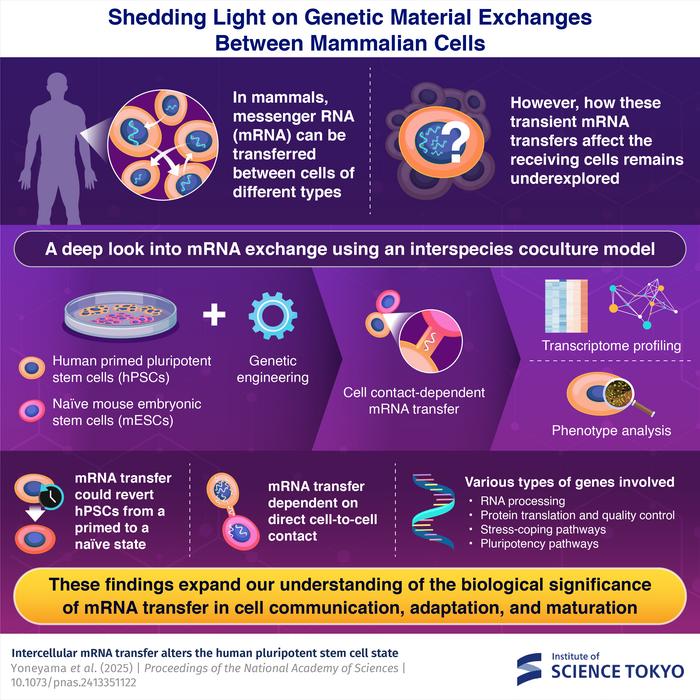Cell-to-cell communication is a fundamental process that sustains life across diverse organisms. In recent years, the understanding of how cells interact has evolved dramatically, particularly concerning the role of RNA in these interactions. Researchers have uncovered that messenger RNA (mRNA), traditionally viewed as a mere carrier of genetic information, plays a vital role in facilitating communication between cells. This revelation has opened new avenues in the field of molecular biology, specifically in the dynamics of cellular communication and its implications for regenerative medicine.
One of the notable mechanisms through which this intercellular communication occurs is through extracellular vesicles. These tiny, membrane-bound sacs are secreted by cells and loaded with various bioactive molecules, including RNAs. Upon release, these vesicles travel to nearby cells, allowing for the transfer of genetic information and regulatory signals. This naturally occurring process underscores the complexity of how cells coordinate their responses to internal and external stimuli, as they communicate to maintain homeostasis, adapt to environmental changes, or modulate developmental processes.
A groundbreaking study led by Professor Takanori Takebe from the Institute of Science Tokyo is shedding light on this important phenomenon. The research team aimed to unravel the mechanisms and implications of mRNA transfer among different stem cell types, responding to an urgent need for a deeper understanding of cell-fate dynamics. Their findings, published in the esteemed journal Proceedings of the National Academy of Sciences, provide compelling insights into the intricate exchanges that happen during stem cell interactions.
Determined to observe these interactions more clearly, the researchers devised a coculture system wherein mouse embryonic stem cells (mESCs) were cultured alongside human primed pluripotent stem cells (hPSCs). This innovative experimental design allowed the team to track RNA movement more effectively. The genetic differences inherent between murine and human cells enabled them to identify and distinguish between the mRNAs produced by each cell type.
As the coculture progressed, the unexpected transfer of mRNA from mESCs to hPSCs became apparent. Through RNA imaging analysis and gene expression profiling, the research group successfully documented the lateral movement of specific mRNAs coding for essential cellular functions related to stress response and gene regulation. This mRNA transfer took place through the tunneling nanotubes formed between the two cell types, proffering a vivid illustration of cellular communication dynamics that was previously underappreciated.
The biological ramifications of mRNA transfer are noteworthy and suggest that this phenomenon plays a significantly more sophisticated role than previously recognized. In their investigation, the researchers observed that the transferred mRNA actively influenced the fate of the receiving stem cells. Notably, particular hPSCs underwent a remarkable transformation, reverting to a ‘naïve’ state reminiscent of early embryonic cells. This finding indicates that mRNA exchange can elicit profound changes in cellular identity and behavior, supporting the notion that intercellular communication is crucial in regulating developmental trajectories.
To further explore the molecular underpinnings of this cellular reprogramming, the team identified key transcription factors activated in the receiving cells following mRNA transfer. These factors are pivotal for maintaining pluripotent states, thus underscoring the regulatory power of mRNA-derived signals in dictating cell fate decisions. The implications of such findings extend beyond fundamental biology; they hint at novel strategies for tissue engineering and regenerative medicine.
The research led by Professor Takebe represents a significant step forward in our understanding of stem cell biology and intercellular communication mechanisms. The ability to manipulate mRNA transfer pathways could pave the way for innovative therapeutic applications, allowing for more refined control over stem cell states without the need for genetic modification or chemical interventions. By harnessing the natural processes of mRNA transfer, new regenerative therapies may emerge, potentially revolutionizing the treatment of various degenerative diseases and injury repair.
In conclusion, this study illuminates the sophisticated nature of cell communication through mRNA transfer, highlighting its potential impact on cell identity and fate. As researchers continue to delve into the mechanisms of RNA exchanges, an exciting frontier is opening in cellular biology, one that could redefine how we approach the manipulation of stem cells in therapeutic contexts.
The exploration of these concepts will be paramount in advancing regenerative medicine and enhancing our comprehension of fundamental biological processes. The potential to leverage mRNA for therapeutic innovation signals a transformative era in molecular biology, making this field one to watch closely in the years ahead. The ongoing investigations promise to unfold layers of complexity in cellular communication and adaptation, driving future research that could greatly affect medical science and biotechnology.
Subject of Research: Cells
Article Title: Intercellular mRNA transfer alters the human pluripotent stem cell state
News Publication Date: 22-Jan-2025
Web References: DOI Link
References: None provided
Image Credits: Science Tokyo
Keywords: Cell communication, mRNA transfer, stem cells, regenerative medicine, tunneling nanotubes, pluripotency, gene expression, cellular reprogramming.
Tags: bioactive molecules in cellular responsescellular communication mechanismsdirect cell-to-cell communication pathwaysextracellular vesicles in cell signalinghomeostasis and cell communicationimplications of mRNA in molecular biologymechanisms of cell signaling in biologymRNA transfer in stem cellsregenerative medicine advancementsrole of RNA in intercellular communicationstem cell research innovationstunneling nanotubes in cell interaction





